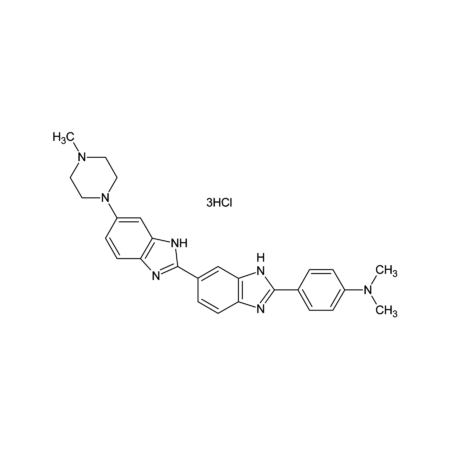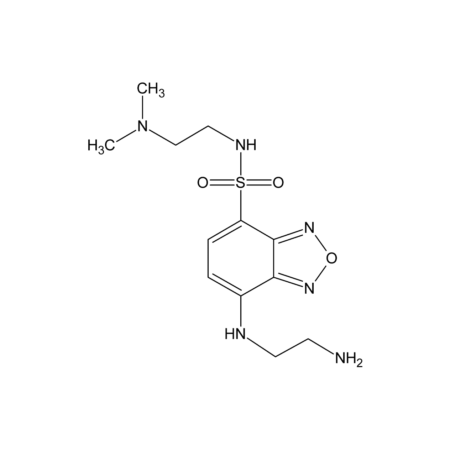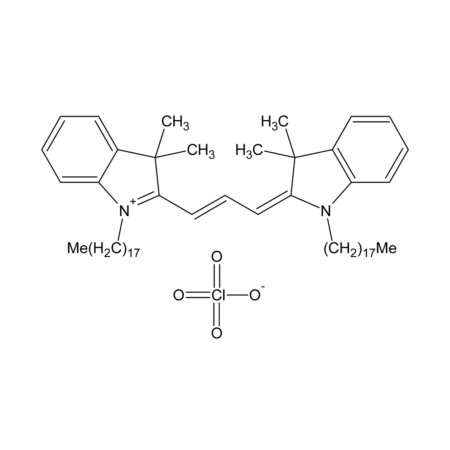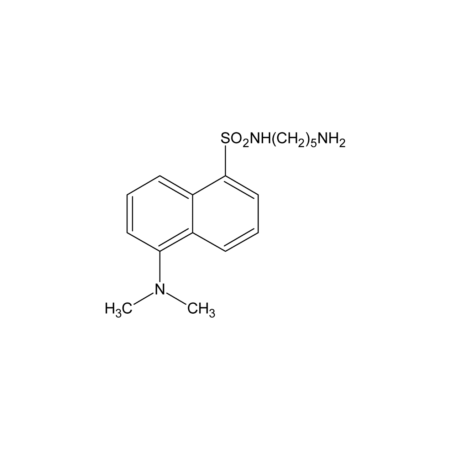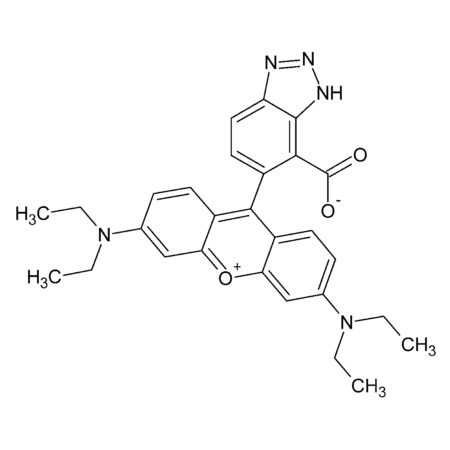Hoechst 34580
- SKU
- B0094
Category: Fluorescent Detection, Fluorescent Detection
- Synonyms
- N,N-Dimethyl-4-[5-(4-methyl-1-piperazinyl)[2,5?-bi-1H-benzimidazol]-2?-yl]benzenamine trihydrochloride
- 911004-45-0
- CAS-Number
- C27H29N7 · 3HCl
- Molecular Formula
- 560.95
- Molecular Weight
Specifications
- Purity
- ≥98% (HPLC)
- Appearance
- Dark yellow powder
- Identity
- 1H-NMR
Properties
- Solvents
- DMSO, DMF, water (1 mg/ml)
- Melting Point
- 173-175 °C
- Fluorescence
- λex 410 nm, λem 468 nm in 50 mM Tris pH 8.0, esterase
Downloads
- Safety Data Sheet
- CDX B0094 MSDS.pdf
- Shipping
- AMBIENT
- Short Term Storage
- +4°C
- Long Term Storage
- +4°C
- Handling Advice
- Protect from light and moisture.
- Use / Stability
- Stable for at least 2 years after receipt when stored at +4°C.
- Transportation
- Not dangerous goods
- Description
- The Hoechst stains are a family of fluorescent stains for labeling DNA in fluorescence microscopy. The blue fluorescent Hoechst dye is a cell permeable nucleic acid stain that has multiple applications, including sensitive detection of DNA in the presence of RNA in agarose gels, automated DNA determination, sensitive determination of cell number and chromosome sorting. Useful vital stain for the flow cytometric recognition of DNA damage and other viability measurements by monitoring the emission spectral shifts of the dyes. Because this fluorescent stain labels DNA, it can also be used to visualize nuclei and mitochondria. Hoechst 34580 can be excited by violet laser at 405 nm, and emit blue/cyan fluorescence light around an emission maximum at ~440 nm. It is cell-permeable and an excellent tool for flow cytometry studies.
Other available Hoechst dyes:
- Smiles
- C[NH+](C)C(C=C1)=CC=C1C(N2)=NC3=C2C=C(C4=NC5=C(C=C([NH+]6CC[NH+](C)CC6)C=C5)N4)C=C3.[Cl-].[Cl-].[Cl-]
- InChi Key
- CKEGKXSZJKGMMN-UHFFFAOYSA-N
- References
- (1) S.A. Latt & G. Stetten: J. Histochem. Cytochem. 24, 24 (1976) , (2) D.P. Kelly, et al.: Aus. J. Chem. 47, 1751 (1994) , (3) W.G. Telford, et al.: Cytometry A. 54, 48 (2003) , (4) D.A. Evans & S. Neidle: J. Med. Chem. 49, 4232 (2006) , (5) W. Lei, et al.: ChemPhysChem 12, 2933 (2011)
- InChi
- InChI=1S/C24H23NO5/c1-2-3-4-5-6-11-22(26)28-17-13-12-16-14-18(24(27)30-21(16)15-17)23-25-19-9-7-8-10-20(19)29-23/h7-10,12-15H,2-6,11H2,1H3
The Hoechst stains are a family of fluorescent stains for labeling DNA in fluorescence microscopy. The blue fluorescent Hoechst dye is a cell permeable nucleic acid stain that has multiple applications, including sensitive detection of DNA in the presence of RNA in agarose gels, automated DNA determination, sensitive determination of cell number and chromosome sorting. Useful vital stain for the flow cytometric recognition of DNA damage and other viability measurements by monitoring the emission spectral shifts of the dyes. Because this fluorescent stain labels DNA, it can also be used to visualize nuclei and mitochondria. Hoechst 34580 can be excited by violet laser at 405 nm, and emit blue/cyan fluorescence light around an emission maximum at ~440 nm. It is cell-permeable and an excellent tool for flow cytometry studies.
Other available Hoechst dyes:

